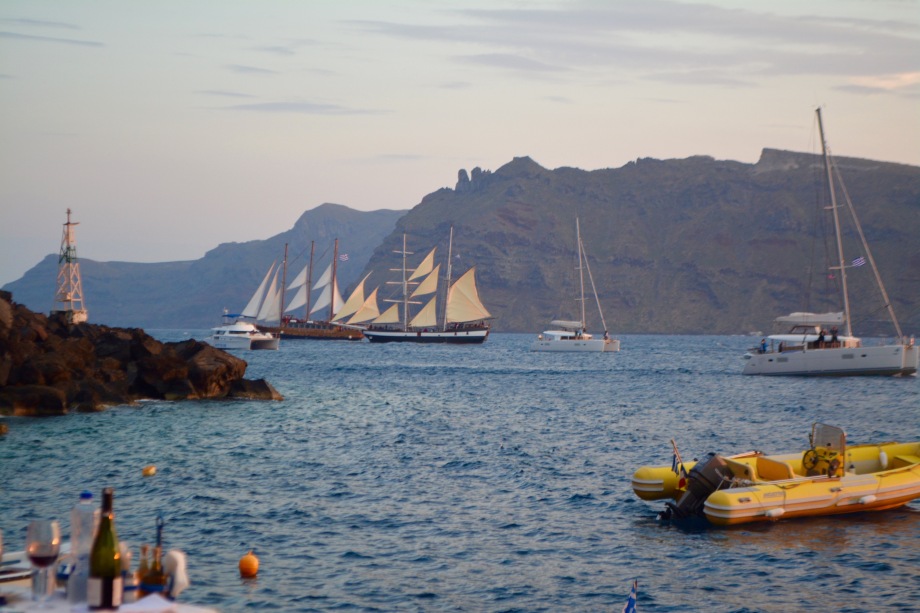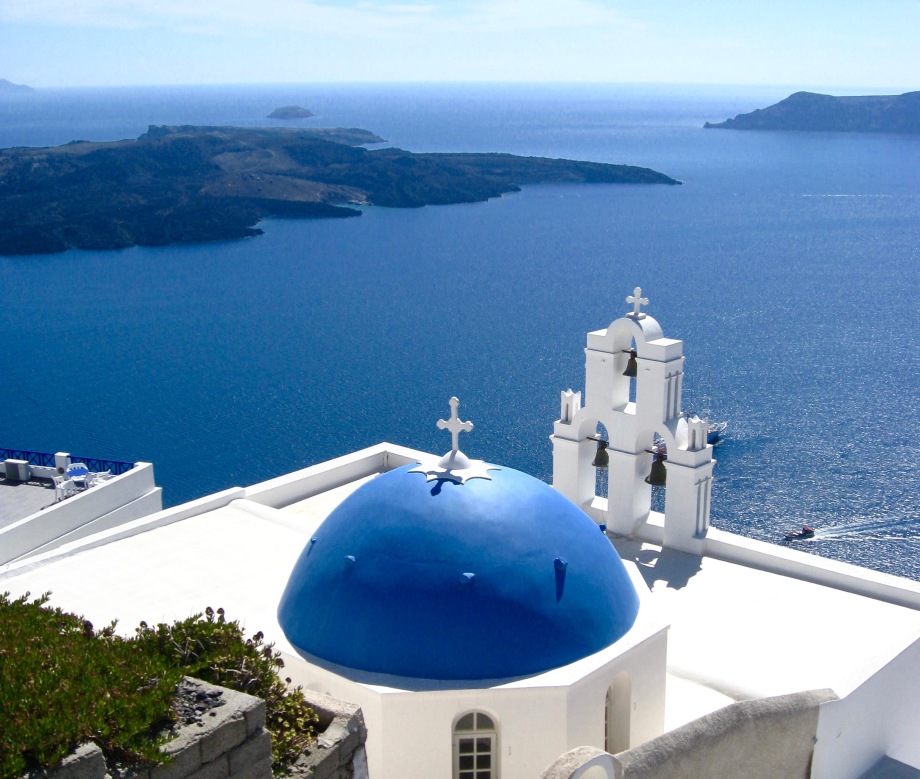
Join Roger Dell, art historian, museum educator and former Harvard lecturer, on a tour of some of the most important archaeological sites of Greece, related museum collections, and a search for the wellspring of western civilization.
ATHENS – CRETE – SANTORINI
DATES: MAY 15-28, 2017
Last Chance ~ Two more rooms to fill. Join us!
This small group tour begins in Athens with an exploration of the archaeological finds from Crete and the Cycladic islands at the National Archaeological Museum and the Goulandris Museum of Cycladic Art. Next we will travel to the island of Crete, once the center of Minoan civilization, with its intriguing palace complexes thought to have been places of worship of a great-mother goddess. Then travel by sea to the spectacular island of Santorini, home of the ancient site of Akrotiri where a sophisticated Minoan settlement thrived over 3500 years ago. But like the story of Plato’s Atlantis, a sudden natural catastrophe brought it to an end. The Minoan culture, Europe’s first civilization, is believed by some scholars to have been the basis for Plato’s Atlantis myth.
Watch lecture with Roger Dell on the Art and Religion of the Minoans, Europe’s First Civilization, on Eurynome Journeys’ Facebook page.
Group size is limited to approximately 12 participants. Price is valid thru December 31, 2016. After this date price is subject to availability.
To reserve you space email: info@eurynomejourneys.com or call 207.236.0110 or 207.200.3752
Tour itinerary
Athens (2 nights)
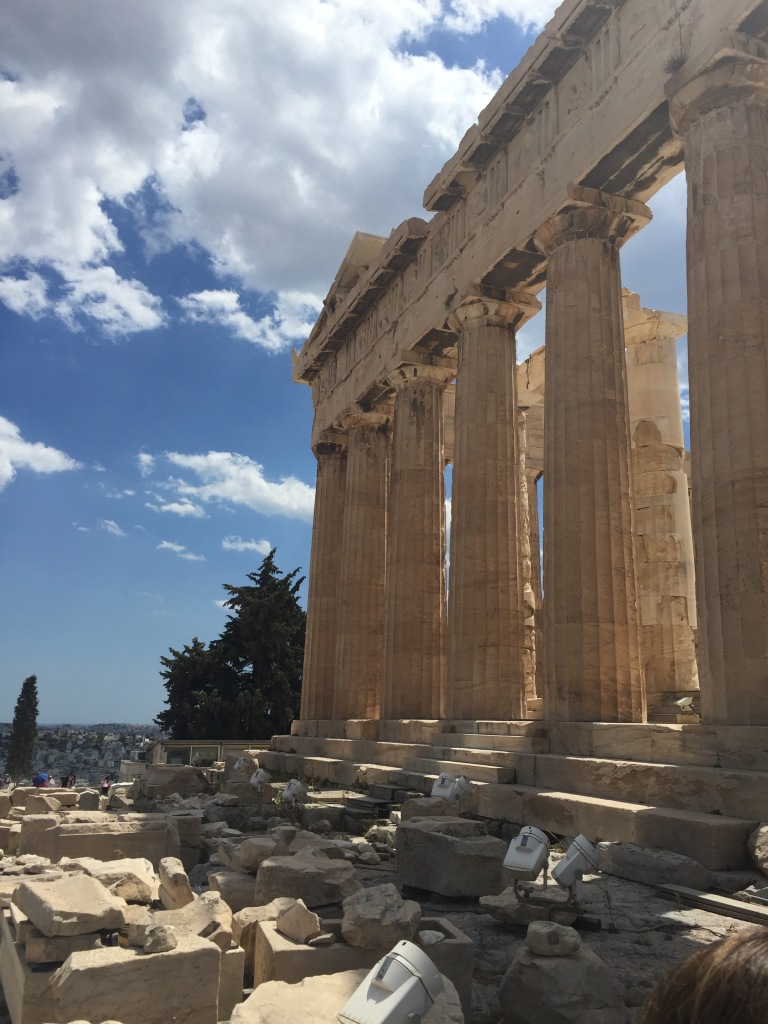
Day 1: Our journey begins with a reception dinner with local wine under the Acropolis welcoming us to Athens, the capital and cultural hub of modern Greece. (D)
Day 2: As an introduction to the ancient cultures of the islands to be visited, we’ll spend the day touring two of Athens’ best collections of ancient Aegean art.
Goulandris Museum of Cycladic Art. This museum displays with the best and latest in museum technologies; its collection is renowned for its masterpieces of white marble sculptures discovered on the islands in the Central Aegean, the Cyclades. We will visit this museum to discover the civilization that began in the 3rd millennium B.C.E. and that flourished on the islands before the arrival of the Minoans and Mycenaeans.
Enjoy a group lunch at a local restaurant, before continuing on to the National Archaeological Museum.
National Archaeological Museum – Surely one of the greatest national museums in the world. From the Neolithic period to the Roman conquest, a visitor could follow the complete course of Greek art unbroken in the galleries of this museum. We will focus on the Bronze Age artifacts from Homer’s “rich in gold” Mycenae, where excavations began in 1871 by the German archeologist Heinrich Schliemann, and the early frescoes and vase-paintings discovered beginning in 1967 at Akrotiri on Thera (Santorini) by the Greek archaeologist Spyridon Marinatos. These extraordinary objects will inform the entire trip, as later we will visit some of the very sites from which the objects were excavated. As we walk through the National Archeological Museum recreating the Bronze Age Aegean in our minds, we will, of course, stop before some landmarks of later Greek art: the Poseidon of Artemision, the Boy of Marathon, the Horse and Jockey of Artemision, the Eleusinian votive relief, and several others. (B, L)
CRETE
Heraklion area (2 nights)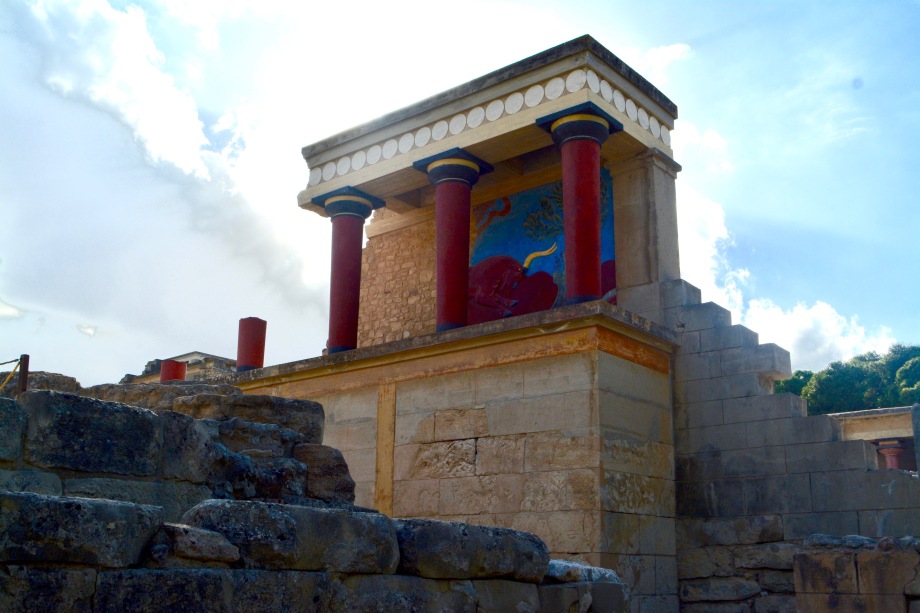
Day 3: Fly to the island of Crete to Heraklion (Iraklio), the island’s modern-day capital city.
First we’ll tour the Archaeological site of Knossos– King Minos. The Minotaur. The Labyrinth. Daedalus. Ariadne. Theseus. Echoing down through the millennia, these names are all associated with this site on a hill known as Kephala, a short ride from the main city of Heraklion. The British archeologist Sir Arthur Evans began excavations at Knossos in 1900, and eventually recreated – using concrete and his rich imagination – the vast palace complex visitors see today. We will spend ample time going through “The Labyrinth,” discussing this center of Minoan civilization in all its splendor and mystery.
Enjoy a family-style traditional Cretan lunch before continuing on to the recently re-opened Heraklion Museum.
Heraklion Museum – Most of the key artifacts unearthed at Knossos and the other major sites on Crete can be found in the Heraklion Museum. Through discussion, we will “place” these objects within the architectural context of Knossos, gaining a fuller insight into the genius of Minoan craftsmanship. Such marvelous works as the bull-leaping fresco, the “Parisienne” fresco, the disk of Phaistos, the faience “Snake Goddess,” the steatite bull head rhyton, and the sarcophagus of Hagia Triada will be carefully examined during this museum visit. (B, L)

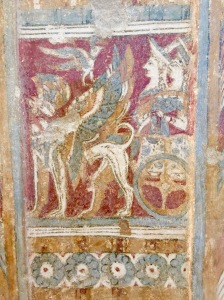
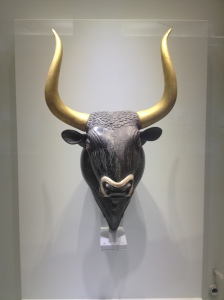
Day 4: Today we continue our exploration of Minoan palaces and settlements. We’ll drive south across the island to the fertile Messara Plain where olives trees, vineyards and other crops are grown. Here we will visit two Minoan sites.
Phaistos — Second in importance only to Knossos is the palace of Phaistos. This palace is known for its well-preserved theatrical area and grand staircase. Of the numerous artifacts found at the site is the Phaistos Disc, which dates to 1600 B.C.E. This clay disc with 241 characters has yet to be deciphered. Recent scholarly analysis suggests that it may be a hymn to the great-mother goddess.
We’ll stop for lunch before continuing toward the coast.
Hagia Triada – Possibly a royal villa used in the summer by the ruler of Phaistos, Hagia Triada is sited on a low hill with a sweeping view of Mount Ida and the Messara. The villa has two wings that are arranged on either side of the central court. It is from this site that the famous stone sarcophagus was found that portrays religious ceremonies on all four sides. We will discuss the possible interpretations of these scenes, which show people conveying offerings of animals and vases, all painted in bright colors.
Return to Heraklion for the night. (B)
Kato Zakros (3 nights)
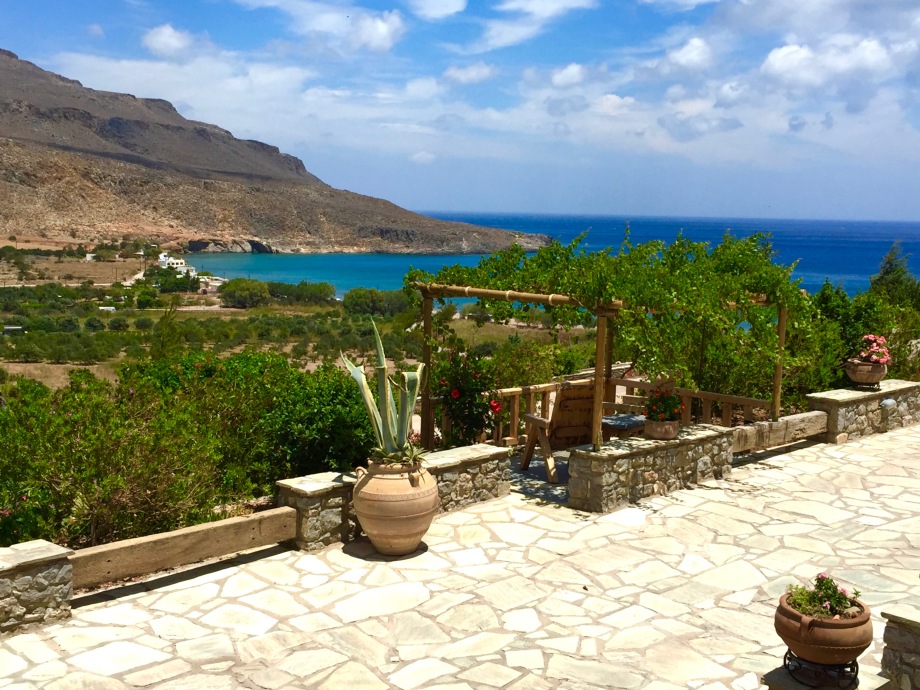
Day 5: We’ll bid farewell to Heraklion for now and travel along Crete’s northern shoreline to the quieter southeastern coast. On our journey we will explore another palace complex, as well as settlements, tombs, and cemeteries all attesting to the prosperity and sophistication of the Minoan civilization.
Malia – Close to the north shore of Crete, the palace of Malia was built at the center of an extensive urban quarter. The visitor approaches the north entrance on the royal road. Along the way, one passes huge pithoi, or storage jars for crops. A kernos (stone dish for offerings) has also been left in situ, and one can only imagine the ceremonies that took place around this lovely artifact.
Before dinner, we will check in at our hotel. Our accommodations for the next three nights will be a small complex of traditional-style Cretan villas on the slope of a valley where the Minoans once lived overlooking the Palace of Zakros and the bay. (B, D)
Day 6: Today we have a full day of touring the southeastern part of Crete visiting the sites of Zakros and Palaikastro.
Zakros –A Minoan palace is perfectly situated opposite the scenic bay of Kato Zakros. From here it was easy for Minoan traders to set out for Egypt and the Near East. Next we’ll drive east along the serpentine roads of Crete to Palaikastro.
Palaikastro – This site at the eastern tip of Crete has yielded one of the most exquisite figurines found on Crete. Larger than most depictions of humans, this image represents a kouros, a young man with erect stature, and was chryselephantine ( made out of gold and ivory). Most probably a cult image because of the rich materials used in the construction, the figure is on view in the Archaeological Museum in Sitia. Near the site, archeologists have found geological evidence that points to a cataclysmic event during the high point of the Late Minoan I A Period.
Sitia – We will visit this small town and view the Palaikastro kouros in the Archaeological Museum. And enjoy free time to relax at the waterfront. (B, L)
Day 7: On our final day in Kato Zakros you’ll have time to enjoy an optional morning hike with our Cretan guide and learn about Crete’s flora and fauna. In the afternoon relax at the nearby beach of Xerocambos, where exposed ruins reveal a Hellenistic settlement. Along the way you’ll discover beautiful undeveloped beaches, with only small tavernas, churches, and no hotels in sight. (B)

Day 8: We’ll travel across the mountainous terrain of the center of Crete to the Lasithi Plain exploring more en route to Heraklion, where we’ll spend out last night on Crete. (B)
SANTORINI (5 nights)
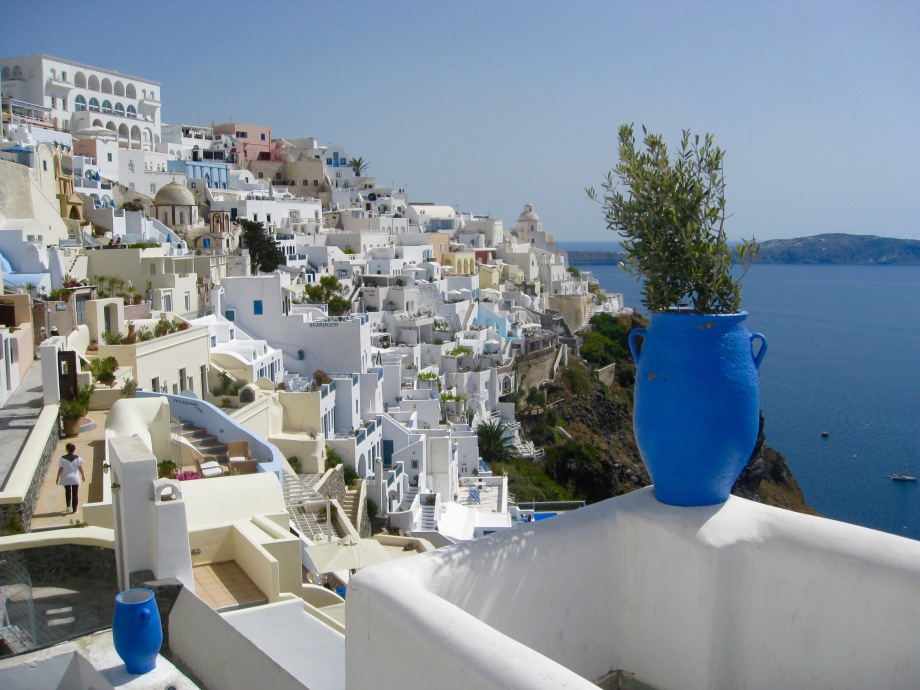
Day 9: Travel by morning ferry to the island of Santorini ( also known as Thera, Thira, Fira)
Upon arrival on this beautiful island, which was sculpted by volcanic activity into a crescent shape, we will drive to the southeastern part of the island to visit the site of Akrotiri; built of red, white and black stones as in Plato’s description of Atlantis:
“One kind was white, another black, and a third red, and as they quarried, they at the same time hollowed out double docks, having roofs formed out of the native rock. Some of their buildings were simple, but in others they put together different stones, varying the colour to please the eye, and to be a natural source of delight.”
Plato, Critas (360 B.C.E.) Translated by Benjamin Jowett
Akrotiri – It has been called “the Pompeii of the Aegean,” however the excavation of the town of Akrotiri is unique in many ways due to its extraordinary state of preservation. Three story buildings, magnificent frescoes (now in the Prehistory Museum and in Athens), and delicate pottery were all buried under the ash fallout from the explosion of the 6,000-foot volcano that made up the core of the island. Thus, a city of maybe 35,000 people was frozen in time, and the Minoan Empire on Crete was dealt a death blow. We will wander the streets of this deserted city, marveling at the similarities and differences between this 3,500-year-old city and modern ones.
Prehistory Museum – This small yet fascinating museum houses the artifacts discovered at Akrotiri. To complement the frescoes observed at the National Archeological Museum in Athens, we will carefully examine several frescoes from the excavation, such as the “Blue Monkeys” and the “Ladies and Papyri.” Also found at the museum are objects that were used in everyday life.
Enjoy a light lunch and wine tasting at one of Santorini’s premier wineries. After lunch we will explore the medieval village of Pyrgos on a walking tour. This small hilltop village with traditional architecture, beautiful churches and a fortress was declared a protected settlement in 1995. (B, L)
Day 10: On our first full day in Santorini we continue our exploration of the island at the Archaeological Museum followed by a guided tour of Ancient Thera. 
Archeological Museum – To round out our exploration of Santorini’s artistic and cultural legacy, we will visit this museum which holds works from periods that followed the Bronze Age, such as Theran vases from the Geometric and Archaic Periods, sculpture from the Archaic to the Roman Periods, and ancient inscriptions. These objects will help us understand Ancient Thera more fully.
Ancient Thera – We will hike or ride up this mountain and behold a panoramic view of Santorini and the surrounding sea. At the summit, we will explore the Archaic period ruins of the island, amongst which we will see some of the earliest Greek writing in existence. This site visitation will provide a context for the objects in the Archaeological Museum. After exploring the site there will be time for a swim and lunch at one of the island’s volcanic black beaches before returning to our hotel. (B)
Day 11: Enjoy a visit to the picturesque village of Oia at the northernmost tip of the island.

Oia – This charming town can be reached by an inspiring walk along the rim of the main island or by local ground transportation. Forty years ago, the town of Oia was sparsely populated due to the major damage by earthquakes associated with the volcano over the centuries. Today Oia is a destination in itself, with busy restaurants and a glittering nightlife, but it is best known for its art galleries and sunsets.
After exploring Oia we’ll visit Amoudi Bay below the village for a traditional Santorinian lunch of local dishes and fresh fish. (B, L)
Day 12: Today will be a day to relax. Enjoy a day aboard our luxury Catamaran for a different perspective of Santorini. Sail by the White Beach, the Red Beach and the volcano at the caldera’s center. As we cruise within the caldera’s steep walls and soak up the splendor this unique geological formation, our crew will prepare a delicious lunch for us. (B, L)

Day 13: Day at leisure to meander around the picturesque alleyways of Thera and enjoy the amenities of our hotel. In the evening we will gather for a special farewell dinner with local wine at one of Santorini’s finest restaurants. (B, D)
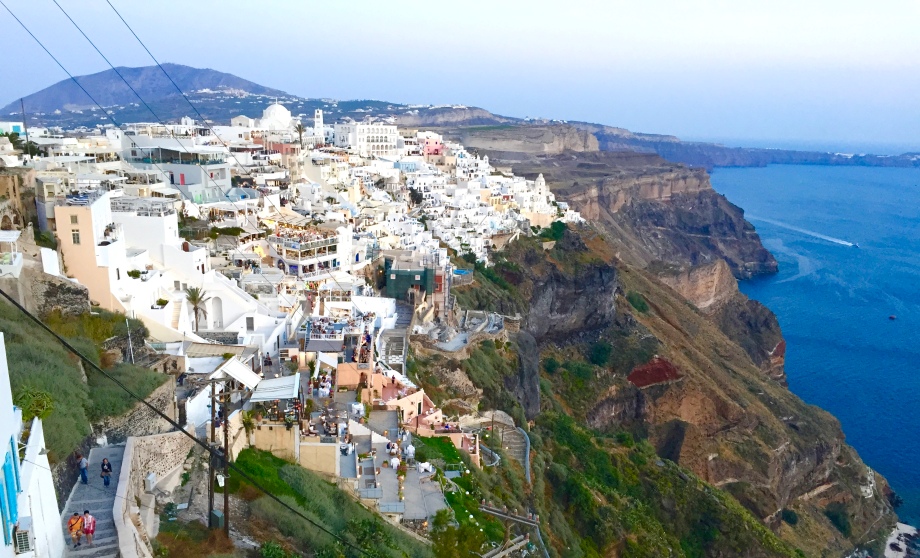
Day 14: After breakfast, transfer to the airport for our flight back to Athens. (B)
Roger Dell and Greece
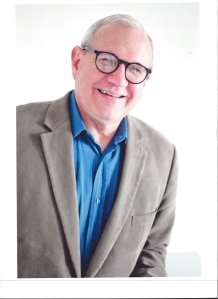 SANTORINI
SANTORINI
In the summer of 1974, my wife Nancy and I travelled throughout Mainland Greece and fell head over heels in love with the country. On a short cruise of the Aegean Islands, we sailed into the otherworldly caldera of Santorini; certainly one of the most awesome natural sites on the planet. Like many of our fellow travelers, we took mules up the 584 steps of the switchback, extra-wide staircase and looked for the best view of the bay during sunset. We had wine on the balcony of the Panorama Hotel as the sky turned fiery pinks, reds and yellows. As time neared for us to descend the staircase, Nancy and I looked at each other and said at the same time, “We must come back!”
We were fortunate enough to have a mini sabbatical in 1978, and so we spent three months in Turkey and Greece, three weeks on Santorini. As our stay on the island drew to a close, we said in unison, “We must come back!” The next year, we returned and rented a cave-house on the sheer cliff face of the main town of Phira, planning to stay for an entire year. The idea was that I would research and write a book about the Bronze Age Aegean, and Nancy would assist me. The locals said, “Nobody stays here for a year. Nobody stays for the winter.” Weeks passed. Months passed. After about six months an islander said, “You two are like lizards. You work under your rock, then you pop out. Guess you really are going to stay!” And, we did.
GREEK ART
I have had a deep and abiding interest in Greece ever since I was a little boy and discovered the magic of Greek mythology. As an undergraduate, I studied Greek art and culture in my Western art history classes. With my Master’s Degree in art history, I have taught semester-long courses in Greek art over the decades in many universities (University of Hawaii, Hofstra University, Johnson State College in Vermont, Burlington College, and University of Vermont). Also, I have lectured widely about the art of Greece and Rome at many colleges, museums and other educational institutions. Moreover, I have travelled throughout America and Europe seeking out in the great museums and collections the finest examples of Greek sculpture and pottery.
WHAT TO EXPECT
This small group tour is limited to approximately 12 participants allowing you to experience, not only personalized tours, but also opportunities to experience modern Greek culture and history. We will tour by air-conditioned motor coach, but a considerable amount of walking is required to fully partake. You should be comfortable walking at a relaxed pace with rest stops for 2 to 4 hours. We will be visiting archaeological sites and walking ancient ways where the terrain can be uneven. Some climbing of stairs is required, especially in on the islands. Thus this tour is NOT suitable for those with limited mobility. There are three optional hikes on the islands of moderate difficulty.
All tour participants will receive packing and suggested reading lists to help in preparation for the tour.
GETTING TO GREECE
The group will meet at Athens International Airport in Athens (ATH), Greece at 11 am on May 15, 2017, from where we transfer to our hotel in the center of Athens. Although international airfare to Athens is NOT included, we will gladly help with making your flight arrangements. Also we can assist you with any pre-or post-tour arrangements in Greece and beyond. If you wold like to arrive a day or two early we can arrange additional nights for you at our hotel in Athens as well as a transfer form the airport. The tour concludes in Athens on May 28, 2017.
TOURS
Art historian Roger Dell will lead all tours and be available for discussions throughout the trip. Roger’s wife Nancy will join the tour to “assist” him with this special return journey to the island of Santorini. As we travel through Greece, you will enjoy informative talks about ancient Greek art, as well as insights into modern Greek life. At the museums and archaeological sites, Roger will select artifacts to discuss in-depth, which best illustrate the sophistication of Minoan culture. Although the focus of the tour is Minoan art, Roger will also discuss early Cycladic art and as well as cultures that came after the Minoans. Through out the trip we will be accompanied by official Greek tourist board guides at all archaeological sites and museums as per the itinerary. All admissions fees to sites and museums in the itinerary are included.
HOTELS
The accommodations in Athens are at a centrally located boutique hotel within walking distance to the Acropolis, the Acropolis Museum, and other points of interest. In Crete our hotel in Heraklion is a centrally located 5-star property with a roof-top pool. In Kato Zakos, Crete we will stay at a lovely complex of traditional Cretan-style apartments equipped with kitchens, sitting rooms and patios overlooking the sea and Zakros archaeological site. Our hotel in Santorini is a luxury property located near the caldera’s edge. All rooms have private bathrooms, a safe box, TVs, and blow-dryers. All the hotels are within walking distance to restaurants and shops. Most of the hotels have a business center, wifi, and laundry service.
EARLY BOOKING PRICE: $4999.00
The price is PER PERSON based on double occupancy for reservations received before December 31, 2016. After this date price is subject to availability.
Small group surcharge: Should the group be less than 12 participants a surcharge of $250 per person will be applied to the balance due.
Single supplement for private room: $1025.00
SOLO TRAVELERS PLEASE NOTE: At the traditional villas in Kato Zakros we have a limited number of single rooms. Thus during the 3 nights there, those with a single room may be required to share a 2 bedroom apartment with one bathroom with one other traveler of the same gender. If you must have a single apartment at the villas add $160 to the single supplement (subject to availability). We can arrange for roommates for solo travelers wishing to share accommodations.
Price includes: 13 nights accommodations in Greece; domestic transportation within Greece as per the itinerary including ferry, air conditioned coach, taxis, and domestic Greek flights, all admissions fees as per the itinerary. Also included are healthy Mediterranean-style meals as noted above (drinks and alcoholic beverages are not included, other than water and breakfast beverages, unless specified above).
RESERVATIONS
To reserve your space, call or email Eurynome Journeys for an application form and terms and conditions. We will hold your space for up to two weeks at which time a $1000 deposit per person is due. Add $150 to deposit for post-tour option. Within 95 days of departure, payment in full is due. Travel insurance should be purchased within 14 days of your first payment.
Click here for a free travel insurance quote from Travel Guard Insurance
This tour involves walking and climbing stairs and thus requires a certain degree of physical fitness. This tour is NOT suitable for those with limited mobility. All group activities are NON-SMOKING.
